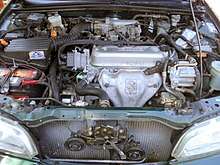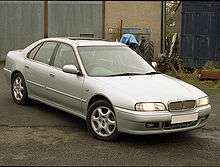Rover 600 Series
| Rover 600 Series | |
|---|---|
 | |
| Overview | |
| Manufacturer | Rover |
| Production | 1993–1999 |
| Assembly | United Kingdom: Cowley, Oxford, England |
| Designer | Richard Woolley (1989) |
| Body and chassis | |
| Class | Large family car (D) |
| Body style | 4-door saloon |
| Layout | FF layout |
| Platform | Honda CB |
| Related |
Honda Accord Honda Ascot Innova |
| Powertrain | |
| Engine |
1.8 L Honda F18A I4 (petrol) 2.0 L Honda F20Z1 I4 (petrol) 2.0 L T-Series I4 (T/C petrol) 2.0 L L-Series I4 (turbodiesel) 2.3 L Honda H23A3 I4 (petrol) |
| Transmission |
5-speed manual 4-speed automatic |
| Dimensions | |
| Wheelbase | 2,720 mm (107.1 in) |
| Length | 4,650 mm (183.1 in) |
| Width | 1,727 mm (68.0 in) |
| Height | 1,380 mm (54.3 in) |
| Curb weight | 1,280–1,365 kg (2,822–3,009 lb) |
| Chronology | |
| Predecessor | Austin Montego |
| Successor | Rover 75 |
The Rover 600 Series is a large family car range that was produced by the British manufacturer Rover from 1993 to 1999.
The Rover 600 exterior was designed by Rover, a re skin of the European Honda Accord, also built in the United Kingdom by Honda in Swindon. The core structure and vast majority of the engineering content was sourced from Honda but the vehicles were designed at the same time, with a small Rover team on site in Japan. Colour and trim derivatives were also used to help separate the Rover from the Honda in the marketplace.
The 1.8, 2.0 and 2.3 litre straight-4 petrol engines were all provided by Honda. However, the 2.0 litre turbodiesel Rover L-Series engine and turbocharged T-Series engines were developed by Rover itself, evolutions of units already available elsewhere in the Rover model range.
The 600's interior included wood and chrome trim, as well as relatively high equipment levels, although rear legroom was criticised as rather constrained.[1] The interior was similar to the Japanese built Honda Ascot Innova, except with a few cosmetic changes. Carpet was also not evident along the bottom trim of the dashboard, although it did feature there on the Innova.
The Honda derived chassis was reported to give a comfortable but unsporting ride. Given the Rover's equipment, prices were reasonably competitive in the large family car segment and considerably lower than the price of such compact executive cars such as the BMW 3 Series and Audi A4.
Launched on 19 April 1993, the 600 Series replaced the Montego saloon in the Rover range, but because the 600 was positioned considerably further upmarket in relation to its predecessor, the entry level Montego models were kept in production primarily for the fleet market.
Unlike the Montego, there was never an estate version of the 600 Series, with no direct replacement being launched for the estate version of the Montego when it was discontinued at the end of 1994. Production continued until the beginning of 1999, when it was replaced with the retro styled Rover 75, developed under BMW's stewardship. The 75 also replaced the larger 800 Series. The 600 had been a popular car in the compact executive sector, with a large percentage of sales being to the fleet market.
In 1984, when in the final stages of developing the Rover 800 Series saloon, it was planned to sell the sell the hatchback version from its launch a year later as the Rover 600 Series, but these plans were abandoned and instead the hatchback became part of the 800 Series.[2]
Versions
The 600 was available in the following versions:
- 618i
- 618 Si
- 620i




- 620 Si
- 620 SLi
- 620 GSi
- 623 SLi
- 623 GSi
- 623 iS
- 620ti
- 620 Di
- 620 SDi
- 620 SLDi
- 620 GSDi
Badging was determined by engine size: 618 models had 1.8 litre engines, 620 had 2.0 engines, 623 had 2.3 litre engines. With the exception of the T-Series 620ti, all petrol engines were sourced from Honda, and all diesel versions were L-Series units. The K-Series engine was not used in the 600.
The 600 was available in a number of different trims. All models had power-assisted steering (PAS), electric front windows, remote central locking with alarm and immobiliser and tinted windows. The Si had split rear seats, Si Auto and above got a sunroof. SLi trim added electric rear windows and wooden door trim; GSi models received 15" multispoke alloys and full leather trim.
From 1994, all cars had a driver's airbag. The 623iS had half leather trim and a small lip spoiler on its boot. The ti featured a set of 16" six spoke alloys with uprated suspension, 'Torsen' gearbox and a dark half leather interior.
Run out models included:
- 618iL
- 618iS
- 620iSD
- 620iLD
S and SD models had the appearance of the 620ti, with the same six spoke 16" alloy wheels and half leather trim. L and LD models had seven spoke 15" alloy wheels and full leather trim resembling the GSi models.
The range was revised/mildly "facelifted" twice. The first revisions were in 1996 which included a slightly revised interior with a padded front arm rest and separate rear head rests, all models, apart from the ti, had 15" wheels, high level brake light, new alarm and immobiliser system (the alarm changed from an infra red to a radio controlled handset and the ignition key became a 'transponder key', without which the immobiliser could not be disarmed), drink holders in the front doors, electric headlight adjuster and all models from Si specification upwards receive air conditioning and 15" alloys.
At this time, the T series changed ignition system from Distributor to 'wasted spark', pistons, Klinger head gasket, LSD and the steering was changed to Rover's Positive Centre Feel (PCF) system. United Kingdom cars which featured these revisions were all badged as "600" only, in line with most other models in the Rover range which no longer had badging by engine sizes.
The final revisions came in 1997, just over a year later, and all cars got slightly lowered suspension (~10 mm) and body coloured sills, rubbing strips, door handles and door mirror covers.
620ti

In 1994, the 620ti was launched. It had a turbocharged, intercooled, 16 valve, twin cam 2.0 litre T series engine, a top speed of 143 mph (230 km/h), and a 0-60 mph time of seven seconds, thanks to 197 bhp (147 kW; 200 PS) and 174 lb·ft (236 N·m) torque. The 620ti also had uprated suspension, dark half leather upholstery, and a set of six spoke 16 inch alloy wheels.
Autocar magazine (February 8, 1995) had an example on a long term test, and found it to be as quick in the mid range as a Ford Sapphire 2.0i Cosworth, following tests at Millbrook Proving Ground.[3]
Production
| Year | Production |
|---|---|
| 1993 | 30,594 |
| 1994 | 54,604 |
| 1995 | 61,533 |
| 1996 | 43,701 |
| 1997 | 40,291 |
| 1998 | 40,815 |
| 1999 | 974 |
| Total | 272,512 |
Reviews
- The AA




 [4]
[4]
'The Rover 600 ... has the finest power units and sweetest gearchange ... its unique aura and good looks will appeal to those who buy with their hearts not their heads. (But) the 600 costs more to buy and run. It is under equipped and takes up a lot of space outside, without offering any of the benefit ... inside.' - Honest John




 [5]
[5]
Positives: Smart looking car, best with 2.3 litre engine, Honda Accord based and the most reliable Rover of its era.
Negatives: Lacklustre ride and handling, prone to inner rear wings rust, T-Series engines suffer head gasket trouble. - RAC




 [6]
[6]
'A sound design that managed to keep the Rover image moving upmarket. If you want British luxury and quality Japanese engineering, the 600 could be just your cup of Earl Grey. Many buyers are now realising what a bargain this combination of cultures represents. Try one and be surprised – it's better than you might think.'
References
- ↑ "Rover 600 (93-00)*". parkers.co.uk. Retrieved 2009-02-09.
- ↑ Adams, Keith (7 August 2011). "Essay : Austin-Rover marketing". AROnline. Retrieved 25 July 2015.
- ↑ Autocar, February 8, 1995
- ↑ "Four of a Kind" (PDF). The AA. Retrieved 2014-06-25.
- ↑ "Classic Car Reviews - Rover 600". Honest John. Retrieved 2014-06-25.
- ↑ "Rover 600 (1993 - 1999) - Car Reviews". RAC. Retrieved 2014-06-25.
External links
- Adams, Keith. "The Unofficial Austin Rover Web Resource".
| Wikimedia Commons has media related to Rover 600. |